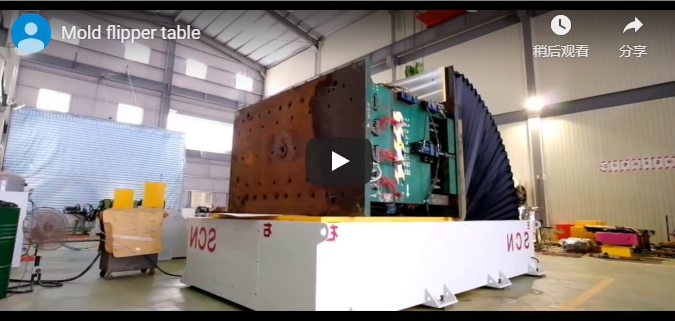Understanding Hydraulic Mold Flipper Tables: Operation, Safety, and Specifications
Handling large, heavy molds is a significant challenge in many manufacturing and tool & die operations. Improper handling not only poses serious safety risks to personnel but can also lead to costly damage to the molds themselves. Hydraulic mold flipper tables, also known as mold upenders or turnover machines, provide a safe, efficient, and controlled solution for rotating and positioning these bulky components for maintenance, repair, or setup.
This guide explores the key features, operational principles, and technical aspects of typical hydraulic mold flipper tables, drawing parallels to best practices often highlighted in fabrication environments.
1. Core Functionality and Operating Principle
At its heart, a mold flipper table uses hydraulic power to rotate a platen or table, typically 90 or 180 degrees. This allows operators to safely turn over heavy molds, providing access to different sides without manual lifting or precarious maneuvering with cranes alone. The hydraulic system provides the necessary force and control for smooth, precise rotation, minimizing shock loads on the mold.
2. Key Features and Design Considerations
Modern mold flipper tables incorporate several features focused on safety, reliability, and ease of use:
- Hydraulic Pressure Maintaining Valve: This critical safety component ensures that if hydraulic pressure is unexpectedly lost (e.g., during a power outage), the table maintains its position, preventing the mold from unintentionally lowering or rotating.
- Low Voltage Control System: Utilizing a 24V control system significantly reduces the risk of electrical shock to operators interacting with the control panel or pendant.
- Diagnostic Indicators: In the event of an equipment fault, integrated diagnostic systems often display the failure status, potentially accompanied by a warning light on the control panel. This allows for quicker troubleshooting and reduced downtime.
- Lubrication System: Rotating components, particularly bearings and heavy contact surfaces, require reliable lubrication. Some designs feature self-lubricating elements like inlaid graphite, supplemented by accessible grease zerks or oil filling holes for routine maintenance, ensuring smooth operation and longevity.
- Pit Installation: Many mold flipper tables are designed for installation within a pit. This allows the table surface to be flush with the surrounding floor level when in the loading/unloading position, simplifying the process of moving molds onto and off the table using forklifts or cranes. Specific foundation drawings are typically provided by the manufacturer.
- Protective Guarding: Components like hydraulic hoses and electrical cables often require protection. Flexible coverings (sometimes referred to colloquially as "snake belly material," often constructed from durable fabrics like 'three anti cloth' supported by PVC) shield these vital parts from damage during operation.
3. Construction and Material Specifications
The robust nature required for handling heavy molds dictates specific material choices and construction techniques:
- Frame and Structure: The main body and turning table are typically fabricated from high-quality steel plates (e.g., Q235 grade steel or equivalent), often ranging from 10mm to 20mm or thicker, depending on the load capacity. Welded construction ensures sufficient strength and rigidity to handle significant loads without deformation.
- Rotating Components: Critical components like idlers and shafts are often machined from durable steel, such as 45# round steel (similar to AISI 1045). These parts undergo processes like lathe finishing for precision and high-temperature quenching (heat treatment) to achieve high strength and wear resistance.
4. Operational Safety and Best Practices
While mold flippers enhance safety, proper operation is paramount:
- Load Capacity: Always adhere strictly to the manufacturer's specified maximum load capacity. Overloading can lead to equipment failure and accidents.
- Centering the Load: Ensure the mold is placed centrally on the table to maintain balance during rotation. Off-center loads can stress the mechanism and potentially cause instability.
- Clear Operating Zone: Maintain a clear area around the machine during operation. Ensure personnel are aware when rotation is in progress.
- Operator Training: Only trained and authorized personnel should operate the mold flipper. Training should cover operating procedures, safety features, and emergency stop protocols.
- Regular Inspections: Conduct routine checks of hydraulic fluid levels, hoses, structural integrity, and safety mechanisms as per the manufacturer's recommendations. Adherence to safety standards, such as those outlined by organizations like OSHA (or relevant national safety bodies), regarding heavy equipment operation is crucial.
5. Integration into Workflow
Mold flipper tables are most effective when integrated seamlessly into the facility's workflow. Consider how molds will be brought to the flipper (e.g., overhead crane, forklift) and removed after rotation. Pit installation greatly facilitates floor-level transfers. Smooth, controlled rotation minimizes delays and potential bottlenecks in mold maintenance or production setup processes.
By understanding the design features, operational requirements, and safety protocols associated with hydraulic mold flipper tables, fabricators and manufacturers can leverage this equipment to significantly improve efficiency and safety in their mold handling operations.


